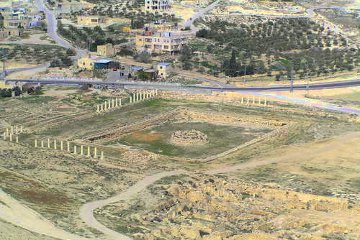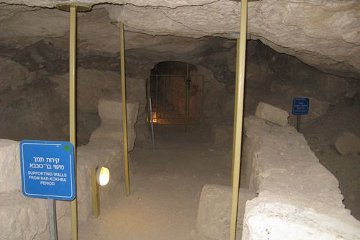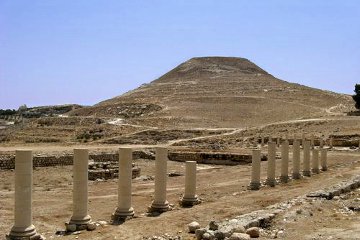Herod's Pools
| Herodion | 31 39 56.69N 35 14 30.58E | Herod's fortress tomb can be seen in remarkable detail. The main pool, with its central island, is just to the north. |
The financial crisis in 1996 meant that archaeological work in Israel had to be dramatically curtailed. Curiously, there was no noticeable reduction in the number of finds reports, as the results from previous excavations continued to be published. Among these was the news from the Herodion that excavators had discovered the oldest indoor swimming pool in Palestine.

| |
| The main pool at the Herodion, with its central island. |
The area around the Herodion today appears to be dry and barren, but in the time of Christ the area must have been alive with greenery and the sparkle of water. At the foot of the hill on which Herod's fortress cum tomb was built was a large pool in which stood a kiosk or rotunda to form a sort of artificial island. The modern road to the Herodion passes beside the ruins of this pool. There were other smaller pools dotted around to provide reservoirs for the gardens that surrounded the palace. In addition, there were as many as 15 small bath-houses surrounding the Herodion, which contained stone tubs or stepped pools.
Excavated into the rock beneath the Herodion are huge cisterns, enabling the inhabitants to stand a prolonged siege. When, during the Jewish revolts, the Herodion was taken over by Zealots (and later by the followers of Bar Kokhba) they elaborated these underground cisterns into a complicated network of tunnels and passages that enabled them to attack the besieging Romans from unexpected angles. In order to keep the Romans in ignorance of what they were doing, the Jews dumped the spoil from these excavations into the cisterns, which I must admit seems rather like cutting off your nose to spite your face!

| |
| The entrance to one of the zealot tunnels beneath the Herodion. |
These pools were a popular form of recreation and were extremely large in consequence. A Herodian pool found at Roman Jericho was 90 yards long! Even on top of the desert fortress of Masada there was a swimming pool 18 x 13 yards. As modern hotels in the Middle East testify, there are few more attractive ways of relaxing than to sit in the sunshine beside a pool of clear, sparkling water. Unfortunately, the Herodion, which is almost at the same height as Jerusalem, is sufficiently high above sea-level to make the evening breezes a distinctly chilly discomfort and it was doubtless with this in mind that Herod built his indoor pool.
Work on the Herodion has only recently recommenced. A plaque by the hut of the guardian commemorates an Israeli murdered by Arabs during the intifada and the modern caretaker always has his Uzi near to hand. Now Professor Ehud Netzer of the Hebrew University is having to halt the digging again, owing to the financial situation.
Mind you, Herod's swimming pools have always been perilous places. In the summer of 35 BC Aristobulos, the 19-year old heir to the Hasmonean throne, was strolling beside the swimming pool in Jericho. A group of men already in the water called to him and encouraged him to join them. As the Hasmoneans were supposed to be priest-kings, this mixing with the common people was definitely not done, but eventually heat and the men‘s teasing persuaded him to throw off his clothes and join them.

| |
| The Herodion, viewed from the far side of Herod's main pool. |
There was a bit of jovial horseplay and when the splashing died down, Aristobulos, last of the Hasmonean line, was dead at the bottom of the pool. Herod, of course, was desolate and staged an impressive funeral at which he and his wife, Aristobulos' sister, the beautiful Mariamne, were chief mourners; but as he immediately stepped into the dead man's shoes as ruler of Israel, everyone, both then and now, feels sure that the men in the pool were acting on instructions.
There are no such macabre tales associated with the Herodion pool — at least, none that we know of — but a Roman mosaic discovered in Sicily some years ago depicts a group of women exercising with a variety of gymnastic equipment. The fascinating thing is that they are shown wearing two-piece costumes identical to the modern bikini. Perhaps Herod's pool could tell a different tale: not of murder, but of the precursor to the modern keep-fit video; all we need now is for the workmen to stumble across a piece of stone on which is inscribed the name JUNO FONDA!





